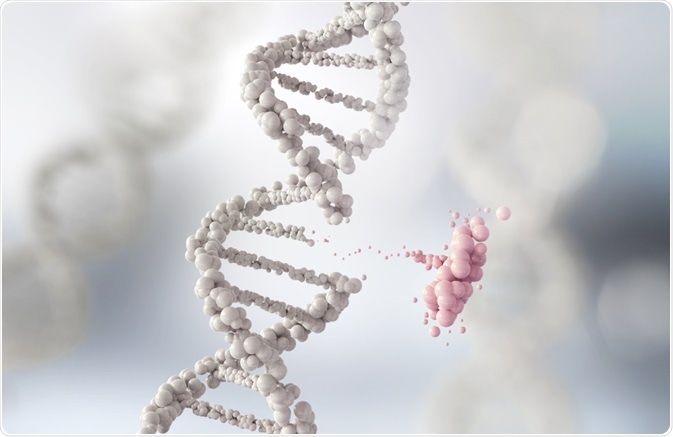What is genetic engineering?
Genetic engineering is the editing of DNA to modify a human or other living organism or population of organisms. While traditionally, scientists have manipulated and modified genetics using indirect methods such as selective breeding and crossbreeding to produce desired traits in plants and animals (usually for agricultural purposes), modern genetic engineering is most often used to refer to the numerous techniques of direct genetic modification that have developed.
Today, the field of genetic engineering has grown to encompass sophisticated methods of genetic modification, the likes of which were previously the subject of science fiction. At the end of the 20th-century recombinant DNA technology, also known as gene cloning, where DNA molecules from one source are combined with those of another (or more) in vivo or in vitro and are artificially introduced into an organism.

Genetic Engineering. Image Credit: Anusorn Nakdee/Shutterstock.com
Applications of genetic engineering
Various industries benefit from genetic engineering, including medicine, agriculture, and research. The methods that have been developed can be used on plants, animals, and microorganisms, opening up the potential applications of the technology.
The medical sector is relying more and more on genetic engineering. It is currently used to mass-produce certain therapeutics such as antihemophilic factors, follistim, human albumin, human growth hormones, monoclonal antibodies, and vaccines.
In the agricultural industry, genetic engineering has aided the production of reliable crop yields through the advent of genetically-modified crops.
In research, genetic engineering has enabled us to learn how particular genes function.
Methods of genetic engineering
Most methods of recombinant DNA technology place foreign genes into common bacterial strains. This often involves implanting genes into the bacterium’s plasmids, small circles of DNA that are not part of the chromosome but contain genetic information and can guide protein synthesis. While they are distinct from chromosomal DNA they can be replicated and passed on like chromosomal DNA.
Through this method, scientists can produce an infinite number of copies of a selected gene. In addition, if the gene can direct protein synthesis, then the modified bacterium will guide the synthesis of the protein coded by the DNA.
Recently, a new generation of genetic engineering has emerged. In 2012, scientists unveiled the CRISPR-Cas9 method. A revolutionary approach that allows scientists to make specific edits to an organism’s genetic sequence. With the theoretical possibility to edit any gene in any way chosen, the technique has an almost limitless range of potential applications.
Agriculture, for example, can use CRISPR to modify crops and livestock to eradicate disease and enhance crop yields, an application that has great significance in regions that struggle to grow enough food.
Medicine also stands to greatly benefit from the technology, which has several applications in gene therapies that could offer effective treatments for a range of diseases such as cancer.
The basis of CRISPR technology is simple. It can locate a specific segment of DNA and alter it, this may be removing it entirely, or replacing it with an alternative piece of genetic code. The technology has also been adapted to turn genes off and on without changing the genetic sequence.
Before CRISPR technology, other methodologies had been able to edit plant and animal genomes, however, they were incredibly time-consuming and costly. CRISPR, on the other hand, offers a relatively cheap and easy method, and, therefore, represents a significant turning point in genetic engineering where suddenly scientists around the world have access to such powerful genetic modification capabilities. The technology has the potential to revolutionize medicine, offering a pathway to new therapeutics to both treat and prevent illness.
The ethics of genetic engineering
With the advent of CRISPR technology and the claimed successful birth of genetically engineered human twins using the method, the debate surrounding the ethics of genetic engineering has heated up.
Scientists highlight the potential dangers of genome editing, such as the potentially severe negative impact of making edits in the wrong place of genetic code or producing mosaicism where some of the organism’s cells carry the edit but others carry the original code. Most scientists agree that the risks of genome editing for clinical reproductive purposes do not outweigh the benefit, and, therefore, are not deemed safe.
In addition, there is great concern over the ability to obtain informed consent for germline therapy, something that is vital for research to continue ethically because those who are affected are the embryo and its future generations. Further to this, it is generally believed that genome editing will only be accessible to those with access to sufficient finances, creating disparities in healthcare quality across demographics.
Overall, genetic engineering is a powerful tool with applications in a variety of industries. With the development of new CRISPR technology, scientists have greater potential than ever before to change the face of science, particularly medicine, with genetic engineering. Scientists have the potential to improve disease prognosis and enhance preventative techniques. However, there is also a potential for “designer babies”, the risk of errors in genetic editing, and the potential to cause disparities in healthcare across the population. For this reason, the applications of genetic engineering will always have to be carefully considered.
Sources:
- Hsu, P., Lander, E. and Zhang, F., 2014. Development and Applications of CRISPR-Cas9 for Genome Engineering. Cell, 157(6), pp.1262-1278. https://www.sciencedirect.com/science/article/pii/S0092867414006047
- Jiang, F., and Doudna, J., 2017. CRISPR–Cas9 Structures and Mechanisms. Annual Review of Biophysics, 46(1), pp.505-529. www.nature.com/.../
- What are the Ethical Concerns of Genome Editing? National Human Genome Research Institute. Available at: www.genome.gov/.../ethical-concerns
Further Reading